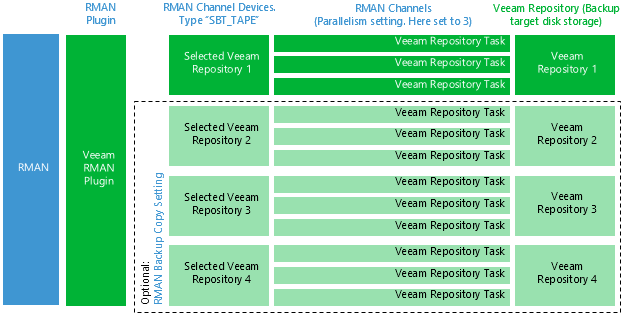 This is an archive version of the document. To get the most up-to-date information, see the current version.
This is an archive version of the document. To get the most up-to-date information, see the current version.Veeam Environment Planning
Before you deploy Veeam Plug-in, keep in mind the following requirements and limitations:
- Veeam Backup Repositories
- RMAN Channels and Veeam Repository Task Slots
- Veeam Backup Job Name
- Hosting Environments
- Plug-in Version
- Veeam Plug-in supports the following Veeam backup repositories:
- Quantum DXi
- ExaGrid. Mind the requirements in the ExaGrid section of the Veeam Backup & Replication User Guide.
- HPE StoreOnce used as a CIFS share or Linux repository with mounted NFS. For details, see HPE StoreOnce.
- You can also use Veeam scale-out backup repositories that contain supported repository types.
- Veeam synthetic processing is not used.
- Scale-out Backup Repository (SoBR) extents will be selected by available free space for each Oracle RMAN channel each time a channel starts a new connection. SoBR Performance or Locality modes do not influence this selection.
- If you want to migrate Veeam backup repositories to a scale-out backup repository and Veeam Plug-in backups are present on the repository, you must do the following:
- Transfer the folders that include backups to an existing scale-out backup repository extent.
- Rescan the scale-out backup repository.
- Set the scale-out backup repository as a target in the Veeam Plug-in settings.
- Rescan the the repository that you want to add.
- Migrate the repository to the scale-out backup repository.
- Veeam backup repositories with enabled Veeam Agent encryption are not supported. You cannot enable repository-based encryption on the repository where Veeam Plug-in backups reside. The plug-in configuration wizard will not show repositories with this setting enabled.
To learn how to disable repository-based encryption in Veeam Agents, see the Setting Up User Permission on Backup Repositories section of the Veeam Agent for Windows User Guide.
If you want to use the same backup target with the repository-based encryption and Veeam Plug-ins, create a second repository in the subfolder for Veeam Plug-in backups.
- Veeam backup copy jobs and Veeam Cloud Tier processing will not process Veeam Plug-in backups.
- Veeam extract utility cannot extract Veeam Plug-in backup files. By design of Oracle RMAN, these files cannot be imported “as files” to RMAN as they contain additional metadata bound to the used SBT device.
RMAN Channels and Veeam Repository Task Slots
- Any parallel channel started by RMAN will use one Veeam backup repository task slot. By design, Oracle Standard Edition can work with one channel. Oracle Enterprise Edition has the option to use multiple channels and you can configure them in the Veeam Plug-in configuration wizard or at the ALLOCATE CHANNEL definition in RMAN scripts. It is recommended to carefully plan repository task slots, so that Oracle RMAN can work with multiple channels in parallel when configured.
- Restore processes will not use Veeam backup repository task slots and connect without waiting for a free task slot. It will use the amount of channels defined in the RMAN configuration or in the ALLOCATE CHANNEL definition in used RMAN scripts. Also, Veeam Explorer for Oracle has the option to define the number of channels used for restore.
- Resource consumption on the Oracle server depends on hardware and Oracle settings. The following hardware resources are recommended based on tests on Skylake processors:
- Oracle server: 1 CPU core and 200 MB of RAM per currently used channel.
- Backup repository server: 1 CPU core and 1 GB of RAM per 5 currently used channels.
The recommended resources are valid only if you use a separate backup repository for Veeam Plug-in backups. If you use the same backup repository for backups of Veeam Plug-ins and Veeam Backup & Replication and/or Veeam Agents, see the requirements for backup repository servers in the Release Notes of Veeam Backup & Replication.
We recommend to contact your Veeam system engineer to optimize the channel settings and resource allocation.
- The AUTOBACKUP control file does not use the repository task slot and will be processed even if there are no free task slots.

- On the Veeam Backup & Replication server, the backup job name will be created automatically based on the server or cluster name and selected repository.
- For environments that use Oracle RMAN copy processing, one job per repository is created.
By default, Veeam Plug-in uses the Oracle server hostname to create a Veeam Backup & Replication job object and backup folder. To be able to distinguish individual servers, it is recommended to set the following entry within the Veeam configuration XML file: <PluginParameters customServerName="hostname.domain.tld" />
- [Linux]: /opt/veeam/VeeamPluginforOracleRMAN/veeam_config.xml
- [Windows]: %PROGRAMFILES%/Veeam/VeeamPluginforOracleRMAN/veeam_config.xml
Example: If your servers in multiple environments have the name dbserver1 and the domains for the 2 environments are customer1.local and customer2.local, you must add the following entries in the plug-in configuration file:
<PluginParameters customServerName="dbserver1.customer1.local" /> <PluginParameters customServerName="dbserver1.customer2.local" /> |
|
For security reasons, it is recommended to use separate repositories for different customers and limit the Veeam Repository Authentication to the specific customer. |
Veeam Backup & Replication and Veeam Plug-in for Oracle RMAN must be installed from the same version package.